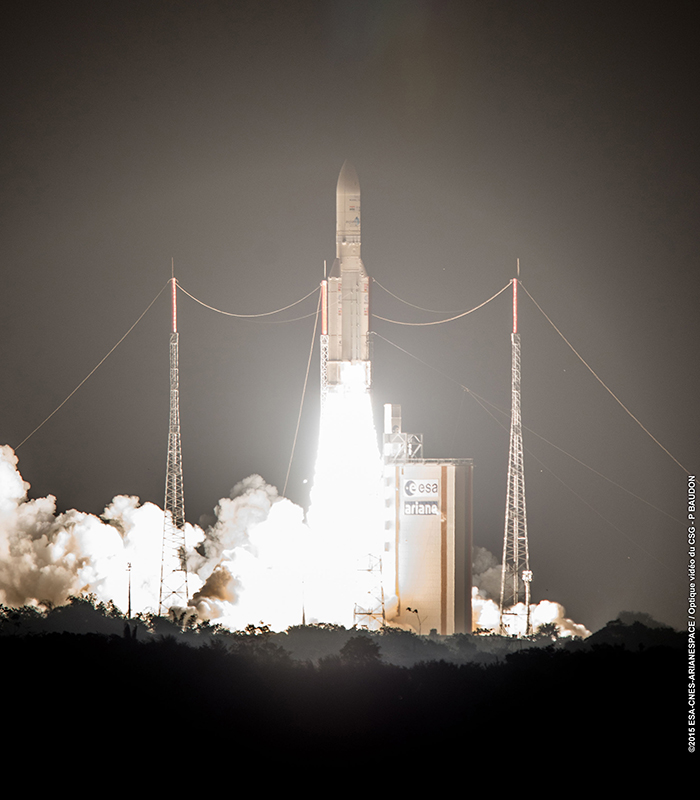
One of the major reasons I blog is to learn. Nothing stretches me more than reading a fascinating article and commenting in public on it. Putting my thoughts out on the never-to-go-away Internet requires a very careful reading of articles.
So if you want to stretch your brain too, stay tuned while I comment on Space News’s coverage on January 6 of a press conference: Arianespace Surpassed SpaceX in Commercial Launch Orders in 2015.
Launch rates
The organization’s CEO provided the following count of commercial orders for 2014. I think this is the count of launches into geo-stationary transfer orbit:
- 9 – Arianespace
- 9 – SpaceX
Article says that reflects Arianespace catching up with SpaceX.
Here is the count of 2015 contracts for geostationary launches:
- 14 – Arianespace, using Ariane 5
- 9 – SpaceX, using Falcon 9
- 1 – International Launch Services, which is for Russia’s Proton lift vehicle
- 1 – ULA, using Atlas 5
Those counts do not include low earth orbit launches.
Arianespace had total of 12 launches in 2015, which is a record number for them. The tally:
- 6 – Ariane 5, which is their heavy lift vehicle
- 3 – Soyuz, which is identified as the medium lift vehicle
- 3 – Vega, which I assume is the light lift vehicle
Arianespace did not give a number for the operating profit but indicated they are at breakeven after counting a €100M subsidy from the European Space Agency.

Falcon 9 recovery
The CEO pointed out it will take time to see if SpaceX’s recovery of a Falcon 9 booster is a game changer or not. He pointed out some of the major challenges:
- whether the stress of launch will damage the engine
- loss of lift capacity due to having enough fuel for recovery; that fuel could instead be used for additional cargo
- the need for large number of launches to make reuse economical; that means a high annual tempo of launches
All of those factors are significant. I am confident all of them will be worked through and resolved, whether by SpaceX or someone else.
Pricing
The CEO indicated the new Ariane 6 heavy lift rocket will be priced in the range of €90M or €100M. That would be something in the range of US$98M or $109M. Article says he said that is about half the launch price for an Ariane 5 launch.
Here’s my recap:
- $200M – $220M – approximate price for an Ariane 5 launch now
- $100M – $110M – estimated price for in-development Ariane 6 launch
Lift capacity of Ariane 5
- 10 tons – to geostationary transfer orbit
- 20 tons – to low earth orbit
Hattip to Beyond the Black for pointing me to the above article. The discussion of Arianespace sales top SpaceX in 2015 pointed out that only one Proton contract in 2015 means SpaceX is taking their launches out of the Russian market share.
Article also wonders how the competition will go if Arianespace drops their price to $100M for Ariane 6 when SpaceX might be able to launch a Falcon 9 for one-third the price.
I don’t know how the competition will work out, but know for a certainty that the competition will make all of the players stronger.
Lift capacity
Since the goal here is to stretch my brain, I looked at the lift capacity for SpaceX.
Falcon Heavy will have 53 metric ton capacity for GTO. A Dragon capsule on Falcon 9 can lift 6 metric tons to LEO. To show how far my brain still needs to stretch, the pricing page shows lots of info that is new to me on capacity and prices:
- $90M – 21 mT to Gto – 53 mT to LEO – Falcon Heavy (aha! mT is abbreviation for metric tons. Stretching my little brain all the time)
- $61m – 4.8 mT to GTO – 13 mT to LEO – Falcon 9
Here is my simplistic comparison:
- Ariane 5 – Falcon 9 – Falcon Heavy – orbit
- 10 mT – 4.8 mT – 21 mT – geostationary transfer
- 20 mT – 13 mT – 53 mT – low earth orbit (my guess this is the correct comparison)
- $200M – $61M – $90M – price